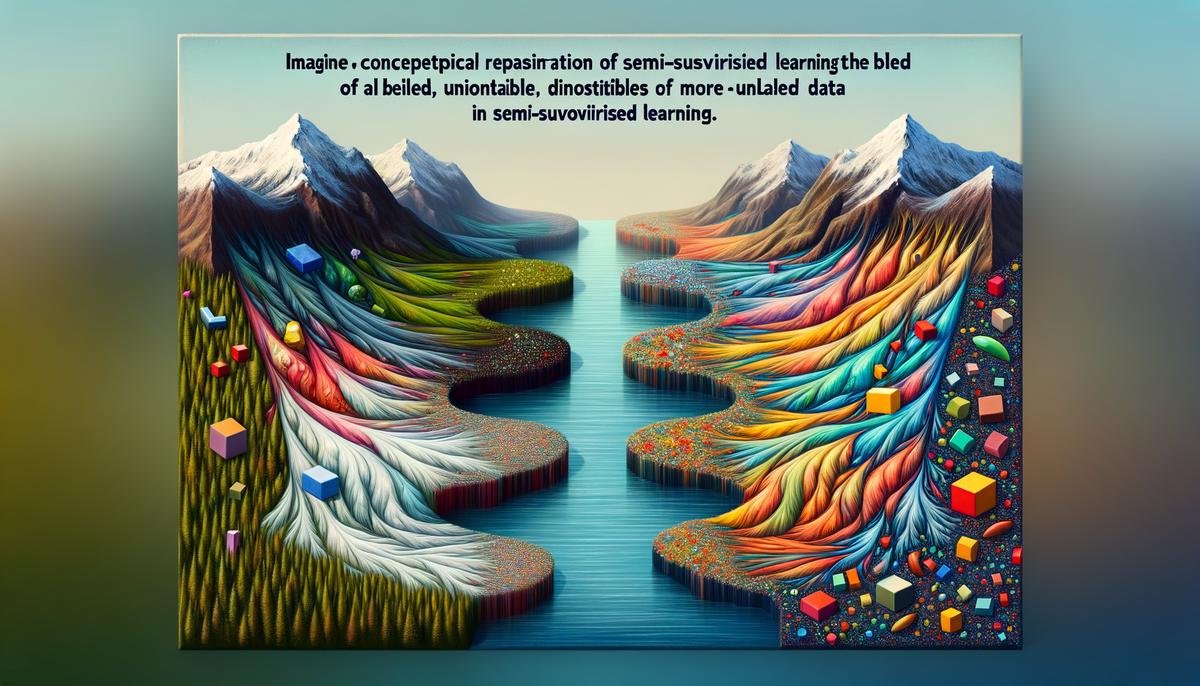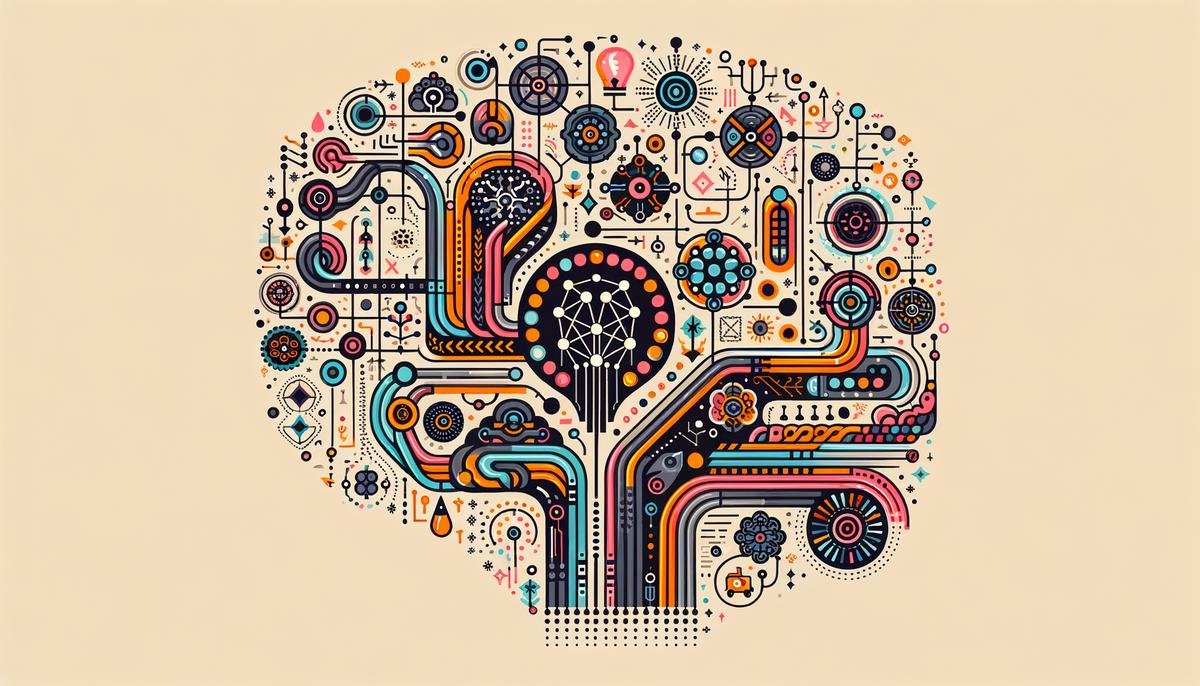Machine learning is a powerful force in today’s technology, shaping how we interact with the digital world. At its core are algorithms, the intricate rules that allow computers to learn from data and make decisions. This article explores the different types of machine learning algorithms, shedding light on how they work and where they’re used. From recognizing patterns in vast datasets to making predictions about future events, these algorithms are key players in the advancement of artificial intelligence.
Overview of Machine Learning Algorithms
Machine Learning Algorithms Explained: From the Basics to Advanced Types
Machine learning is all around us, powering everything from search engine results to recommendations on streaming platforms. At the heart of these marvels are machine learning algorithms, complex sets of rules that enable machines to learn from data and make decisions. The world of machine learning is vast, but it’s primarily built upon four types of algorithms: supervised, unsupervised, semi-supervised, and reinforcement learning. Each plays a crucial role in how machines interpret and act upon the data they’re fed.
Supervised Learning: The Guided Approach
Supervised learning algorithms are like teaching a child with flashcards. Here, the algorithm is trained on a labeled dataset, which means each example in the dataset is paired with the correct answer. The algorithm learns by comparing its predictions to the actual outcomes to find errors. It adjusts until it can accurately predict an outcome based on given inputs. Supervised learning is commonly used for tasks like spam detection in emails where the labels could be “spam” or “not spam.”
Unsupervised Learning: Discovering Hidden Patterns
Unsupervised learning algorithms are handed a pile of data and tasked with finding patterns or structures on their own. Unlike supervised learning, there aren’t any right or wrong answers here, and the data isn’t labeled. It’s like handing someone a jigsaw puzzle without showing them the picture on the box. They must figure out how the pieces fit together based on their shapes and colors. This type of learning is perfect for market segmentation, where businesses divide customers into different groups based on purchasing behaviors without predefined categories.
Semi-Supervised Learning: A Mix of Both Worlds
Semi-supervised learning sits between supervised and unsupervised learning. In this approach, the algorithm learns from a dataset that’s partially labeled. This method is beneficial when acquiring a fully labeled dataset is too expensive or time-consuming, but you have plenty of unlabeled data. Semi-supervised learning is effective in many real-world scenarios, such as classifying a large set of images when only some have been tagged.
Reinforcement Learning: Learning Through Trial and Error
Reinforcement learning is a different beast altogether. It’s about taking suitable actions to maximize reward in a particular situation. It’s akin to training a dog with treats: the dog performs actions and gets rewards or penalties based on what it does right or wrong. Over time, it learns to repeat actions that lead to treats (rewards) and avoid those that don’t. This type is widely used in game playing and robotics where the machine or agent learns to make sequences of decisions.
In conclusion, machine learning algorithms are the wizards behind the curtain in much of today’s technology, enabling systems to learn from data and improve over time. Whether it’s the precise recommendations from a video streaming service or the spam filter in your email, supervised, unsupervised, semi-supervised, and reinforcement learning algorithms are tirelessly at work. Understanding these fundamental types provides a window into the vast possibilities of machine learning applications and their profound impact on our daily lives.

Supervised Learning Algorithms
Supervised learning algorithms are a cornerstone of artificial intelligence, leveraging labeled datasets to train models. These models, in essence, learn to map input data to desired output through repeated exposure to various examples. This training occurs under the guidance of a corrective framework, whereby the algorithm adjusts its parameters to minimize errors in its predictions.
Let’s delve deeper into how these algorithms function. Initially, a dataset, comprising examples with known outcomes, is fed into the algorithm. This dataset is split into two portions: a training set and a test set. The training set is like the main course, where the algorithm digests the information and learns by recognizing patterns. The test set, on the other hand, acts as a final exam to assess how well the algorithm can apply its learned knowledge to new, unseen data.
Focusing on popular algorithms such as Linear Regression, Decision Trees, and Support Vector Machines (SVMs), one can appreciate the diversity in supervised learning’s approach to problem solving. Linear Regression, for example, predicts numeric values based on independent predictor variables. It forms a linear relationship to understand how changes in predictors alter the output. Imagine predicting a house’s price based on its size and location – that’s Linear Regression at work.
Decision Trees, in contrast, operate through a series of binary decisions, each node of the tree representing a decision based on an attribute’s value. This process continues until a prediction is made at a leaf of the tree. It’s akin to a game of twenty questions, where each question gets you closer to your target answer through a process of elimination.
Support Vector Machines, or SVMs, provide another approach. They strive to find the best boundary that separates classes of data with as wide a margin as possible. Visually, if you had to draw a line separating two kinds of points on paper so that they’re as far apart as possible, you’re employing the principle behind SVMs.
Applications of these algorithms span various fields, underlining their versatile utility. In healthcare, for example, supervised learning can predict patient outcomes based on historical health data, contributing to personalized medicine. In the financial sector, these algorithms assist in credit scoring and fraud detection by analyzing transaction patterns and customer profiles. Meanwhile, in the realm of natural language processing, they power tools that perform sentiment analysis or classify documents into categories.
Reflecting on the discussed algorithms and their applications highlights both the adaptability and specificity of supervised learning methods in tackling diverse challenges. With continuing advancements in AI and machine learning, the potential of these algorithms extends even further, promising even more innovative applications in the future. Whether predicting market trends, enhancing customer experiences, or advancing scientific research, the foundations laid by supervised learning algorithms remain crucial in the journey toward an increasingly data-driven world.

Unsupervised Learning Algorithms
Unsupervised learning algorithms stand in stark contrast to their supervised counterparts by not relying on annotated or labeled data, making them particularly adept at identifying patterns and insights from data without explicit prior direction. This means, in unsupervised learning, the algorithm must discern structure from the data on its own. Among the various algorithms that fall under this category, K-Means Clustering and Principal Component Analysis (PCA) are two notable examples, each serving unique roles in the realm of data analysis and pattern recognition.
K-Means Clustering is an algorithm that identifies clusters within a dataset based on the similarity of data points. The “K” in K-Means refers to the number of clusters the algorithm attempts to identify. This process involves assigning each data point to the nearest cluster while keeping the clusters as distinct as possible. The use of K-Means Clustering spans various applications, such as market segmentation where businesses can categorize customers based on purchase history, or in image compression to reduce the number of colors that appear in an image, significantly decreasing its file size.
On the other hand, Principal Component Analysis (PCA) is a technique used to reduce the dimensionality of large data sets, enhancing interpretability while minimizing information loss. This is achieved by transforming the data to a new set of variables, the principal components, which are uncorrelated and order such that the first few retain most of the variation present in all of the original variables. PCA finds use in exploratory data analysis and for making predictive models. It’s particularly helpful in scenarios where the relationship among data points in high-dimensional space needs to be visualized in two or three dimensions, such as in genomic data analysis or even in finance to analyze stock market trends.
The application of unsupervised learning extends far beyond K-Means Clustering and PCA. These algorithms are instrumental in anomaly detection, used in cybersecurity to identify unusual patterns that could signify a security breach. They are essential in recommendation systems, like those employed by streaming services and e-commerce sites to suggest products or movies to users by understanding their interests.
Unsupervised learning’s versatility and power lie in its ability to work with unstructured data, uncover hidden patterns, and provide insights without needing a guiding hand. This makes it an invaluable tool in fields where the questions are not fully formed, or where exploratory analysis can lead to new discoveries. Whether in marketing, genomics, finance, or cybersecurity, unsupervised learning algorithms offer a path to unraveling the complexity of data, allowing businesses and researchers to make informed decisions and predictions.

Semi-supervised Learning Algorithms
In the realm of machine learning, semi-supervised learning stands out as a pivotal approach for maximizing the efficiency of data usage. It forms a bridge between the two conventional learning styles – supervised learning, which relies on labeled data, and unsupervised learning, which works with unlabeled data. Semi-supervised learning algorithms harness the strengths of both these methods to improve learning accuracy and effectiveness, especially in scenarios where labeled data is scarce or expensive to obtain.
Understanding how semi-supervised learning functions requires a dive into its mechanisms of operation. Typically, a semi-supervised algorithm starts with a small amount of labeled data alongside a larger pool of unlabeled data. Herein lies its primary strength – the ability to learn from both datasets, using the labeled data to guide learning outcomes while extrapolating those findings to understand and utilize the patterns hidden within the unlabeled data. This reduces the need for extensive labeling while simultaneously improving the model’s capability to make accurate predictions or recognize patterns on new, unseen data.
One can observe real-world applications of semi-supervised learning in various disciplines, yet its efficacy shines remarkably in fields like speech recognition, image classification, and natural language processing (NLP). For example, in image recognition tasks, these algorithms can use a limited set of labeled images to categorize objects and then apply those categorizations to classify a much larger set of unlabeled images. This is especially crucial given that labeling large datasets for training purposes can be prohibitively expensive or time-consuming.
Language translation models also benefit significantly from semi-supervised learning. By training on potential pairs of sentences – one in the source language and the corresponding translation less entirely verified – the models can improve their accuracy over time without necessitating the painstaking process of manually labeling each phrase.
It’s clear that semi-supervised learning, by leveraging both labeled and unlabeled data, presents a compelling solution for many of the limitations found in supervised and unsupervised learning alone. It acknowledges the reality that while labeled data is invaluable for guiding learning processes, there is also immense unused potential in the vast quantities of unlabeled data available. By embracing a semi-supervised approach, algorithms can achieve higher levels of accuracy and efficiency, providing significant advancements in areas where obtaining ample labeled data remains a challenge.
Thus, semi-supervised learning serves as an essential middle ground, allowing for the effective utilization of all available data – labeled and unlabeled. It fosters an environment where machines can learn more comprehensively, reducing dependency on large sets of labeled data, and representing a cost-effective strategy for improving machine learning algorithms’ performance across diverse sectors.

Reinforcement Learning Algorithms
Reinforcement learning
stands apart from other learning paradigms by allowing algorithms to learn optimal actions through trial and error, interactively adapting to their environment. This unique approach draws inspiration from how humans and animals learn from the consequences of their actions, shaping behavior through rewards and penalties.
Central to understanding reinforcement learning is the notion of agents. These agents are programmed to make decisions, and their goal is to maximize cumulative rewards in an environment. The process begins with the agent observing the state of the environment, taking an action based on its observations, and then receiving feedback in the form of rewards or penalties. This feedback guides the agent’s future decisions, gradually improving its strategy to achieve its goal.
Analyses of algorithms such as Q-Learning and Deep Q Network (DQN) provide clarity on how these mechanisms actualize the reinforcement learning principles. Q-Learning, a form of model-free reinforcement learning, enables an agent to learn the value of an action in a particular state without requiring a model of the environment. It updates the value (Q-value) associated with a state-action pair based on the reward received and the anticipated future rewards. The agent uses this updating mechanism to iteratively improve its policy.
Deep Q Network (DQN), on the other hand, extends Q-Learning’s capacity by integrating deep learning. This involves using a neural network to approximate Q-values, allowing the algorithm to tackle problems with high-dimensional state spaces that are intractable for traditional Q-Learning methods. The success of DQN is emblematic of how deep learning can enhance reinforcement learning, exemplified by its remarkable performance in mastering a wide array of video games.
The applications of reinforcement learning algorithms span several innovative fields. In gaming, these algorithms have not only achieved human-competitive performances in complex games but also discovered novel strategies, illuminating unexplored aspects of game theory. Furthermore, autonomous vehicles use reinforcement learning to make decisions in real time, navigating through challenging and dynamic environments. By simulating a multitude of scenarios, these algorithms learn to predict outcomes of different actions, from which they can ascertain safe and efficient driving strategies.
Understanding reinforcement learning’s iterative process—spanning observation, action, and feedback—sheds light on its ability to evolve strategies over time. Through methodologies like Q-Learning and DQN, reinforcement learning demonstrates its profound capability to process complex decisions and adapt to multifaceted environments. This adaptability not only holds promise for intellectual challenges within gaming but also heralds significant advancements in the development and deployment of autonomous vehicles, showcasing the broad potential of reinforcement learning algorithms in shaping the future of technology.

Comparative Analysis of Machine Learning Algorithms
Navigating the Complex World of Machine Learning: Analyzing Different Algorithms
In the extensive arena of machine learning, different algorithms serve unique functions depending on the issue at hand. The advancement in technology has given rise to a variety of methodologies each with their strengths, weaknesses, and ideal scenarios of application. Here, we delve into a comparative analysis of several prominent algorithms beyond the well-known ones already discussed, focusing on their scalability, accuracy, and computational efficiency.
Neural Networks: The Mimickers of Human Brain Function
Neural networks, inspired by the human brain’s architecture, excel at recognizing patterns and making predictions. Their strength lies in their ability to learn and improve over time, making them highly effective for tasks involving image and speech recognition. However, they require substantial datasets and computational resources, limiting their applicability for businesses without such resources. Furthermore, their “black box” nature often makes it challenging to understand how decisions are made, complicating debugging and improvement.
Random Forests: Ensemble Learning’s Crown Jewel
Random Forests thrive by creating multiple decision trees to produce a more accurate and robust prediction. Their strength lies in versatility, being adept at classification, regression, and even outlier detection tasks. This algorithm is less prone to overfitting compared to individual decision trees, thanks to the aggregation of predictions. However, its weakness is the model’s complexity; it can be computationally intensive to train and challenging to interpret due to its ensemble nature.
Gradient Boosting Machines (GBM): Turning Weakness Into Strength
GBM builds on the foundation of decision trees in a sequential correction mode, often resulting in superior prediction accuracy. By focusing on correcting previous trees’ errors, it tends to outrun Random Forests in terms of precision. Nevertheless, this algorithm’s downside is its susceptibility to overfitting if not tuned properly and its intensive computational requirement, especially with large datasets.
Naive Bayes: The Simple Yet Effective Approach
Naive Bayes classifiers operate under a simple principle: they assume the presence of a particular feature in a class is unrelated to any other feature. While this might sound overly simplistic, this algorithm is surprisingly effective for tasks such as spam detection and document classification. Its strength is its speed and efficiency, particularly with text data. However, this assumption of feature independence is also its most significant limitation, rendering it inaccurate for complex, interconnected datasets.
Conclusion
Each machine learning algorithm comes with its set of pros and cons, shaped by the underlying assumptions about the data it is designed to process. The choice between neural networks, random forests, gradient boosting machines, and Naive Bayes—or any other algorithm—ultimately hinges on the specific requirements of the task at hand, including scalability, accuracy demands, and available computational resources.
By assessing the intricacies of these algorithms, one gains a clearer perspective on forming nuanced strategies for effective machine learning applications. In navigating the labyrinthine world of machine learning algorithms, awareness and understanding of these strengths and weaknesses transform into a roadmap guiding towards more informed decisions in the realm of artificial intelligence.

Future Trends in Machine Learning Algorithms
In the field of machine learning algorithm development, the evolution continues beyond the foundational concepts like supervised and unsupervised learning. Emerging trends and future directions like federated learning, explainable AI (XAI), and quantum machine learning are shaping the prospects of technological advancements. This exploration delves into those areas, providing a glimpse into the future trajectory of machine learning developments.
Federated Learning, a novel approach that focuses on training algorithms across decentralized devices while keeping data localized, is heralding a new era of privacy and efficiency in machine learning. Unlike traditional methods that require data to be centralized, Federated Learning enables devices like smartphones and tablets to learn a shared prediction model while keeping the training data on the device itself. This method not only enhances privacy by minimizing data centralization but also paves the way for personalized models that learn directly from the user’s data without compromising confidentiality.
Another significant advancement in the field is Explainable AI (XAI). As AI systems become more complex, their decisions can sometimes be opaque, leading to a “black box” phenomenon where the reasoning behind an AI decision is not transparent. However, XAI seeks to make AI decisions more understandable to humans. By developing models that can explain their thought processes, developers aim to build trust with users and improve accountability. Explainable AI could revolutionize sectors like healthcare and finance, where understanding AI decisions is crucial for compliance and ethical considerations.
Additionally, the integration of quantum computing with machine learning is an area of explosive potential. Quantum computing operates radically differently from traditional computing, manipulating data through quantum bits (qubits) to perform complex calculations at unprecedented speeds. When applied to machine learning, quantum computing could dramatically accelerate algorithms’ learning capabilities and tackle problems currently out of reach. Though still in its nascent stages, research into quantum machine learning suggests it could revolutionize fields by providing solutions to computationally intensive problems like drug discovery and climate modeling.
Moreover, advancements are not limited to these areas alone. Techniques that harness large language models and generative adversarial networks (GANs) continue to push the boundaries of what machine learning algorithms can achieve, from producing realistic synthetic media to advancing natural language understanding.
The constant evolution in machine learning algorithm development signifies a future where technology is increasingly sophisticated, personalized, and aligned with ethical standards. As researchers and developers work hand in hand to navigate these advancements, the possibilities for application across various sectors—from healthcare to cybersecurity, finance, and beyond—are expanding at an unparalleled pace. With these emerging trends and future directions, the landscape of AI technology continues its relentless march forward, promising transformations that were once mere science fiction.

The exploration of machine learning algorithms reveals a dynamic field at the forefront of technological innovation. As we look toward the future, these algorithms stand as pillars supporting a wide array of applications across industries. They not only enhance our interaction with technology but also promise to unlock new frontiers in understanding and capability. The ongoing development and refinement of these tools will undoubtedly shape an exciting era for artificial intelligence, offering endless possibilities for solving complex problems and improving our daily lives.




